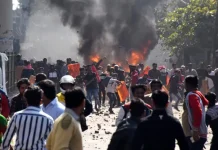New coronavirus infections in India dropped slightly on Monday but the daily death count remained above 4,000 and experts said the count was unreliable due to a lack of testing in rural areas where the virus is spreading fast.
India had set bleak record as no other country in the world had reported more than 400,000 infections in a day.
Even with a downturn over the past few days, experts said there was no certainty that infections had peaked, with alarm growing both at home and abroad over the highly contagious B.1.617 variant first found in India.
“There are still many parts of the country which have not yet experienced the peak, they are still going up,” World Health Organisation Chief Scientist Soumya Swaminathan was quoted as saying.
Swaminathan pointed to the “very high” national positivity rate, at about 20 percent of tests conducted, as a sign that there could be worse to come.
“Testing is still inadequate in a large number of states. And when you see high test positivity rates, clearly, we are not testing enough.
“And so, the absolute numbers actually don’t mean anything when they are taken just by themselves; they have to be taken in the context of how much testing is done, and test positivity rate.”
Having begun to decline last week, new infections over the past 24 hours were put at 281,386 by the health ministry on Monday, dropping below 300,000 for the first time since April 21. The daily death count stood at 4,106.
At the current rate India’s total caseload since the epidemic struck a year ago should pass the 25 million mark in the next couple of days. Total deaths were put at 274,390.
Hospitals have had to turn patients away while mortuaries and crematoriums have been unable to cope with bodies piling up.
It is widely accepted that the official figures grossly underestimate the real impact of the epidemic, with some experts saying actual infections and deaths could be five to 10 times higher.
While lockdowns have helped limit cases in parts of the country hit during an initial surge of infections in February and April, such as Maharashtra and Delhi, rural areas and some states are dealing with fresh surges.
The government issued detailed guidelines on Sunday for monitoring Covid-19 cases, with the health ministry asking villages to look out for people with flu-like illness and get them tested for coronavirus.
Modi has come under fire for his messaging to the public, a decision to leave key decisions on lockdowns to states, and the slow rollout of an immunisation campaign in the world’s biggest vaccine producer.
India has fully vaccinated just over 40.4 million people, or 2.9 percent of its population.
Earlier, a top virologist on Sunday said that he had resigned from a forum of scientific advisers set up by the government to detect variants of the coronavirus.
Shahid Jameel, chair of the scientific advisory group of the forum known as INSACOG, declined to say why he had resigned but said he was concerned that authorities were not paying enough attention to the evidence as they set policy.









